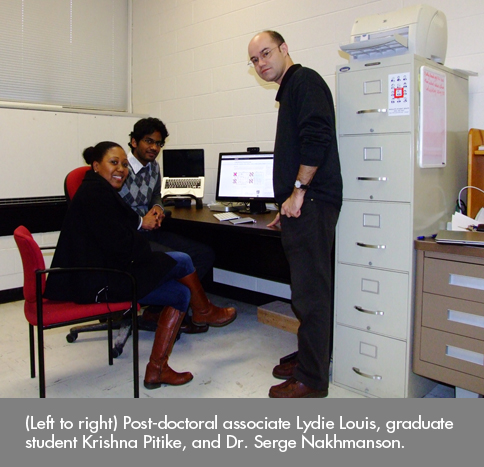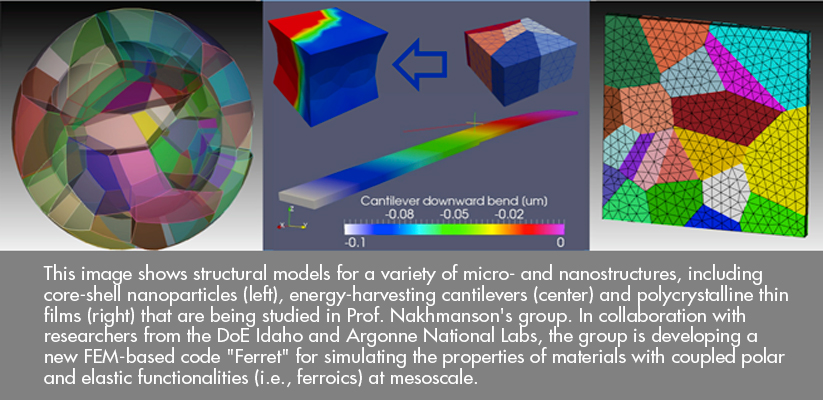MSE Faculty Feature: Dr. Serge Nakhmanson
By Giorgina Paiella
What do materials science research and Lewis Carroll’s literary works share in common? According to MSE Professor Dr. Serge Nakhmanson, quite a bit.
“To stay current in this field, you have to be quick on your feet, and to get somewhere from where you are, you must move even faster,” says Dr. Nakhmanson. It is like the Red Queen’s race in Carroll’s Through the Looking Glass:
“Well, in our country,” said Alice, still panting a little, “you’d generally get to somewhere else — if you run very fast for a long time, as we’ve been doing.”
“A slow sort of country!” said the Queen. “Now, here, you see, it takes all the running you can do, to keep in the same place. If you want to get somewhere else, you must run at least twice as fast as that!”
 He continues, “In order to keep innovating, making discoveries and creating new trends in materials science at a rapid pace, we have to move really fast. Being a scientist himself, Lewis Carroll knew what he was writing about.” Such a sentiment echoes the goals of programs like the Materials Genome Initiative, a collaborative government venture aimed at accelerating the discovery, manufacture, and deployment of advanced materials at a fraction of the cost.
He continues, “In order to keep innovating, making discoveries and creating new trends in materials science at a rapid pace, we have to move really fast. Being a scientist himself, Lewis Carroll knew what he was writing about.” Such a sentiment echoes the goals of programs like the Materials Genome Initiative, a collaborative government venture aimed at accelerating the discovery, manufacture, and deployment of advanced materials at a fraction of the cost.
Dr. Nakhmanson first joined the UConn MSE department in the winter of 2013 and started teaching as an Associate Professor this past August. Dr. Nakhmanson’s research utilizes the principles of solid-state physics, chemistry, and computer science to design and discover advanced multifunctional materials. While he works with laws of quantum mechanics on the length scale of individual atoms and bonds, Nakhmanson also acknowledges the essential collaborations between theorists who develop novel materials concepts and experimentalists who actually grow and characterise these materials. This symbiosis facilitates the exchange of ideas and the flow of information across different disciplines and expertise areas, accelerating the discovery of novel compounds with advanced properties.
Professor Nakhmanson received his Ph.D. in 2001 from Ohio University, where he studied the properties of amorphous materials with first‐principles and empirical simulation techniques with Professor David A. Drabold. He then joined Professor Jerry Bernholc at North Carolina State University as a junior postdoctoral fellow to investigate the polar and piezoelectric properties of BN nanotubes and electroactive polymers. In 2004, Dr. Nakhmanson joined Professors David Vanderbilt and Karin Rabe at Rutgers as a senior postdoctoral researcher working on prediction and enhancement of polar properties of functional complex oxide heterostructures.
 Prior to joining the UConn MSE Department, Dr. Nakhmanson was a staff member in the Interfacial Materials group of the Materials Science Division at Argonne National Laboratory starting in 2006, where he focused on designing and evaluating new electroactive materials with a variety of computational approaches. His research interests include the development of methodologies for rational design of multifunctional ferroic materials — including complex oxide, polymer and molecular crystal compounds —exploring phase transformations in these materials with the help of quantum mechanical computations to optimize their properties, and mesoscale simulations to study their behavior at long time and extended length scales.
Prior to joining the UConn MSE Department, Dr. Nakhmanson was a staff member in the Interfacial Materials group of the Materials Science Division at Argonne National Laboratory starting in 2006, where he focused on designing and evaluating new electroactive materials with a variety of computational approaches. His research interests include the development of methodologies for rational design of multifunctional ferroic materials — including complex oxide, polymer and molecular crystal compounds —exploring phase transformations in these materials with the help of quantum mechanical computations to optimize their properties, and mesoscale simulations to study their behavior at long time and extended length scales.
Dr. Nakhmanson’s research group currently includes a post-doctoral associate, Dr. Lydie Louis, a graduate student, Krishna Pitike, and an undergraduate student, Lukasz Kuna. The group is also involved in ongoing collaborations with Dr. William Parker and Dr. Shiyuan Gu, Dr. Nakhmanson’s postdocs at Argonne.
On joining UConn MSE, Professor Nakhmanson states: “I am very happy to be here, as UConn, and my academic department in particular, provide a perfect match for the work that I do. IMS is a unique structure that unites researchers and professors from multiple departments and disciplines to work together in a transparent fashion. This impresses me very much, as such involved cooperation, rather than competition, is not always the case elsewhere.”
More information about Nakhmanson’s research can be found on his research group’s website: http://satori.ims.uconn.edu/.
Published: January 27, 2014
Categories: faculty, news, research
Available Archives